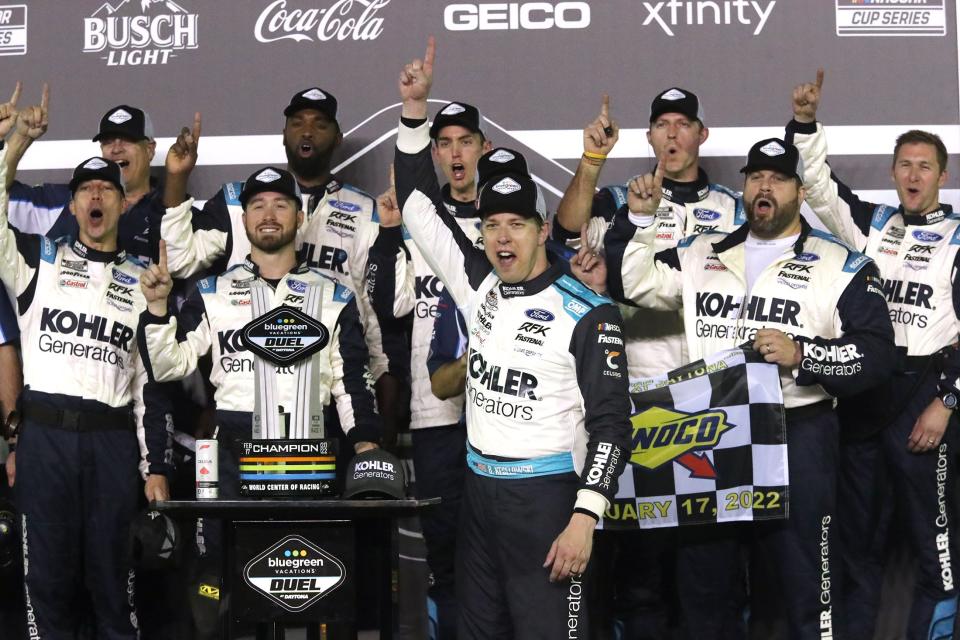NASCAR at Daytona: Thursday 'Duels' have changed, but plenty still at stake for some
DAYTONA BEACH — The starting lineup for Sunday’s Daytona 500 will depend on what happens Thursday night.
While Wednesday night’s pole qualifying set the front row for Sunday’s green flag, the other 38 entries will earn their starting spots in a pair of 150-mile qualifying races (7 p.m., Fox Sports 1).
And since 42 teams have entered and only 40 spots are offered for Sunday, two crews will perform the longest push in motorsports, rolling their car back to the hauler for the long ride home on I-95 North.
It’s a Daytona tradition, but it hasn’t survived without some tweaks, both large and small.
NASCAR's Daytona Duels were born as Twins and caused a lot of "Thursday flu" cases
Perhaps no race day at Daytona has changed as much as the Thursday preceding Daytona 500 weekend.
It’s changed in distance, from 100 to 125 and now 150 miles. Changed in name, from the time they were known as “The Twins” to a long evolution of corporate naming rights — today they’re collectively known as the Bluegreen Vacations Duel.

NASCAR SPEED FREAKSAfter McDowell and Cindric, who's Daytona 500's next 1st-time winner?
MIKE JOYFox NASCAR broadcaster still passionate about racing, Daytona 500
Most notably, they moved from Thursday afternoon to evening nearly a decade ago. In earlier times, the Twins always caused a large uptick in locals calling in "sick” on that one Thursday a year in order to spend the afternoon in the Daytona bleachers or infield.
Also in earlier times, a lot more was usually at stake. Only a handful — OK, maybe two handfuls — of drivers were once guaranteed spots in the Daytona 500. The others had to race their way in through the qualifying races, with only their original pole-day speed as a potential backup pass into the Great American Race.
For those regulars who performed decently the previous year, a few "provisional starting spots" were kept in reserve for emergency purposes.
With the top 15 finishers in each qualifier earning Daytona 500 starts, and often with 30 or more cars in each qualifier, long-ago Thursdays often brought the most spirited competition of Speedweeks.
Jimmie Johnson, Travis Pastrana among those needing to race into the Daytona 500
The free-for-all aspect has largely diminished in modern years. The advent of the charter system has, for all intents and purposes, created franchises for 36 teams, and those 36 teams are guaranteed starting spots at each race on the schedule.
That means the six non-charter teams in town are competing for four available parking spots on Sunday’s starting grid.
The six teams and their drivers: Legacy Motor Club (Jimmie Johnson), 23XI Racing (Travis Pastrana), Front Row Motorsports (Zane Smith), Kaulig Racing (Chandler Smith), Beard Motorsports (Austin Hill), The Money Team Racing (Conor Daly).
NASCAR's Daytona 500: How 42 entries will become 40 starters
The logistics: Each Thursday night qualifying race will have 21 entries, with 18 chartered teams and three non-charters in each. Starting lineups are determined by Wednesday night’s qualifying speeds.
The highest-finishing non-charter team in each race makes the 500. The other two available spots go to the non-charters with the best qualifying speed from Wednesday night.
In recent years, some of the best stories, and wildest final laps, have come courtesy of drivers picking their way through traffic and finding the right lane to make the last-lap dash past the competition and into the Daytona 500.
And once in the Great American Race, the possibility for historic heroics are there for all.
That’s something that hasn’t changed.
This article originally appeared on The Daytona Beach News-Journal: Daytona Duels set NASCAR's Daytona 500 lineup; 2 teams will go home

